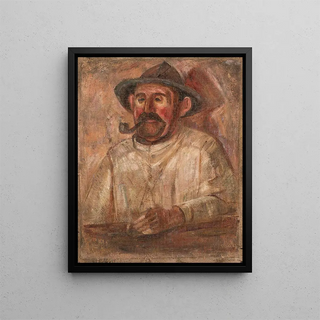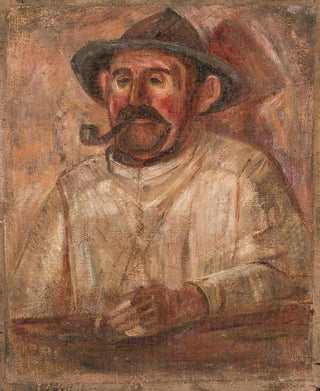Art print | Bust of a man with a hat and a pipe - Tadeusz Makowski Source: Reproduction | Buste d'homme au chapeau avec une pipe - Tadeusz Makowski


View from behind

Frame (optional)
In the fascinating world of art, every piece tells a story, an emotion, a period. The "L Buste d'homme au chapeau avec une pipe" by Tadeusz Makowski is no exception. This work, imbued with deep reflection on human nature, captures the eye and invites contemplation. The depicted figure, both anonymous and universal, seems to seize a suspended moment, where time stands still and the observer is invited to delve into the thoughts of this mysterious man. The pipe, a symbol of reflection and wisdom, reinforces this invitation to introspection, while the hat adds a touch of sophistication, evoking a bygone era when every clothing detail carried meaning.
Style and uniqueness of the work
Tadeusz Makowski's style is distinguished by its unique approach blending figurative and abstract elements. In this art print, the simplification of forms and the use of warm colors create an atmosphere that is both intimate and universal. The texture of the face, subtly modeled, reveals a sensitivity that touches the viewer. Every shadow, every light, is carefully thought out to bring this character to life, while leaving a part of mystery. The composition, although centered on the bust, suggests a narrative depth that invites imagining the life of this man. Makowski, through this work, manages to transcend the simple portrait to offer a reflection on identity and the human condition.
The artist and his influence
Tadeusz Makowski, Polish artist of the early 20th century, knew how to mark his era with his unique style and artistic vision. Influenced by the avant-garde movements of his time, he developed an approach that combines tradition and modernity. Makowski often explored themes related to daily life, melancholy, and the human soul. His work, although sometimes tinged with sadness, is also rich in colors and emotions. His influence extends beyond Poland's borders, touching generations of artists who see in him a precursor of modernity. The "L Buste d'homme au chapeau avec une pipe" embodies this

Matte finish

View from behind

Frame (optional)
In the fascinating world of art, every piece tells a story, an emotion, a period. The "L Buste d'homme au chapeau avec une pipe" by Tadeusz Makowski is no exception. This work, imbued with deep reflection on human nature, captures the eye and invites contemplation. The depicted figure, both anonymous and universal, seems to seize a suspended moment, where time stands still and the observer is invited to delve into the thoughts of this mysterious man. The pipe, a symbol of reflection and wisdom, reinforces this invitation to introspection, while the hat adds a touch of sophistication, evoking a bygone era when every clothing detail carried meaning.
Style and uniqueness of the work
Tadeusz Makowski's style is distinguished by its unique approach blending figurative and abstract elements. In this art print, the simplification of forms and the use of warm colors create an atmosphere that is both intimate and universal. The texture of the face, subtly modeled, reveals a sensitivity that touches the viewer. Every shadow, every light, is carefully thought out to bring this character to life, while leaving a part of mystery. The composition, although centered on the bust, suggests a narrative depth that invites imagining the life of this man. Makowski, through this work, manages to transcend the simple portrait to offer a reflection on identity and the human condition.
The artist and his influence
Tadeusz Makowski, Polish artist of the early 20th century, knew how to mark his era with his unique style and artistic vision. Influenced by the avant-garde movements of his time, he developed an approach that combines tradition and modernity. Makowski often explored themes related to daily life, melancholy, and the human soul. His work, although sometimes tinged with sadness, is also rich in colors and emotions. His influence extends beyond Poland's borders, touching generations of artists who see in him a precursor of modernity. The "L Buste d'homme au chapeau avec une pipe" embodies this






